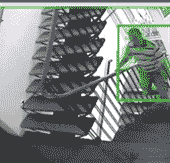
Transit in Transition
Swedish transportation provider increases ridership with advanced security system
- By Megan Weadock
- Sep 05, 2007
 TRANSPORTATION security continues to be tested around the world, especially in Europe, where attempted bombings and terrorist plots—including the summer’s failed car bombings in London and Scotland—have become increasingly common.
TRANSPORTATION security continues to be tested around the world, especially in Europe, where attempted bombings and terrorist plots—including the summer’s failed car bombings in London and Scotland—have become increasingly common.
However, even in the face of grand-scale threats, security officials are still responsible for defending transportation systems from everyday dangers, including robberies, vandalism and injuries. This is the challenge Stockholm LokalTrafic (SL), Stockholm, Sweden’s public transportation provider, faced recently when officials realized crime was taking a toll on ridership.
SL was established in 1967 with the goal of creating one company to run all the transportation within Stockholm. Today, SL operates Stockholm’s metro lines, buses, and commuter and local trains, serving 600,000 passengers a day.
With a reach that includes about 100 train stations and more than 2,100 buses, SL faced a daunting challenge when it was time to modernize and centralize its security system.
A Growing Problem
“Public transportation is very important to the people of Stockholm and is strongly encouraged by the local government,” said Henrik Virro, project manager for SL.
Regardless of the fact that residents wanted and were encouraged to use public transportation, in recent years, vandalism and robberies on buses and trains made the public lose faith in the safety of SL’s system. The company was not meeting its ridership goals, and prospective riders were missing out on the benefits of public transit over cars.
Security officials realized in late 2004 that SL’s system would need an overhaul to achieve the company’s new goals: decrease robberies and attacks, give police evidence of crimes, cut the cost of vandalism, reduce the number of injuries and deaths, shorten response times to alarms, and minimize false alarms and public transit disruption.
Dagan Sadeh, CEO of Visual Defence, the Ontario, Canada-based systems integrator SL chose to update its security network, said one of the major weaknesses of SL’s old, analog systems was the scalability factor.
“When you’re looking at implementing hundreds or thousands of cameras with an analog system, you are looking at huge amounts of bandwidth. Fiber optics are required, and it becomes very expensive,” he said. “Additionally, with individual, non-converged systems, risk mitigation is much more difficult. Information gathering takes longer, operator decision making is more difficult and it is harder to ensure that the proper procedures are followed.”
Although the conversion represented a major financial investment, Virro realized that was what it would take to bring people back to SL. In fact, more than 95 percent of SL’s passengers polled about the project said they were behind the investment.
Getting Centered
Visual Defence converted SL’s old, disparate security methods into one central system: the Command and Control Center (3C) Video and Event Manager. The 3C software, an open architecture platform, gives SL a single point of management for all subsystems and edge devices, including CCTV, video analytics, fire alarm, intrusion detection, access control, IP intercom help phones, driver alarms, scheduling, ticketing and mobile digital video storage for approximately 10,000 cameras on the fleet of buses.
“The vision of SL was to have one common system for all video and safety alarms,” Sadeh said. “The system needed to be able to integrate with existing cameras and security subsystems, as well as provide the flexibility and scalability to handle future requirements. The 3C meets all of their present requirements and is fully scalable, so it can meet the needs of SL as it grows.”
Using 3C, security managers create workflows for appropriate responses to possible events. Those workflows are translated into step-by-step instructions for operators to follow, which help to remove decision-making requirements from operators and reduce the risk associated with human errors, Sadeh said. When an event occurs, it may require an automatic response, a manual response or both. For example, the system can be set to automatically start recording a certain event, but it also can call for a manual response from the operator to confirm the status of the event.
All cameras installed in the system are linked into the 3C software, allowing security officials unprecedented access to surveillance video.
“As long as there is a network connection, we can watch the video wherever we are,” Virro said. “We used to have to carry disks around to give to the police, but with this new system, video can be downloaded from the network, and the police can have access to that and can pick out the specific video they need.”
Video surveillance in SL’s train stations is now done by both analog and digital cameras, while the bus system has gone entirely digital—each of the several thousand buses will feature five IP cameras and one Visual Defence Mobile Digital Video Storage System (DVSSm). The DVSSm acts as a mobile video recorder and streamer and works in conjunction with network cameras to provide high image quality and PoE, which allows cost-efficient installations. When an event occurs on a bus, the video is flagged by the central monitoring station and downloaded into the 3C system through a WiFi connection once the bus enters a depot.
Peace of Mind
The new system not only deters criminal activity, it also has convinced Stockholm residents that public transportation is reliable and safe again. After the overhaul was completed, SL made a point of making the enhanced security known—to both passengers and would-be criminals.
“We notified the public that we’d installed cameras on buses and on platforms at SL, and we posted camera symbols in stations, so people know they are under constant camera surveillance,” Virro said. “Now our passengers know there is constant surveillance and that any violence or crime will be detected. Our ridership has increased, and with it our revenues have gone up.”
The influx of passengers on the public transportation system couldn’t have come at a better time. Stockholm implemented a congestion fee in August that penalizes those who travel into certain parts of the city by car, creating an even stronger incentive for residents and visitors to reap the benefits of public transit.